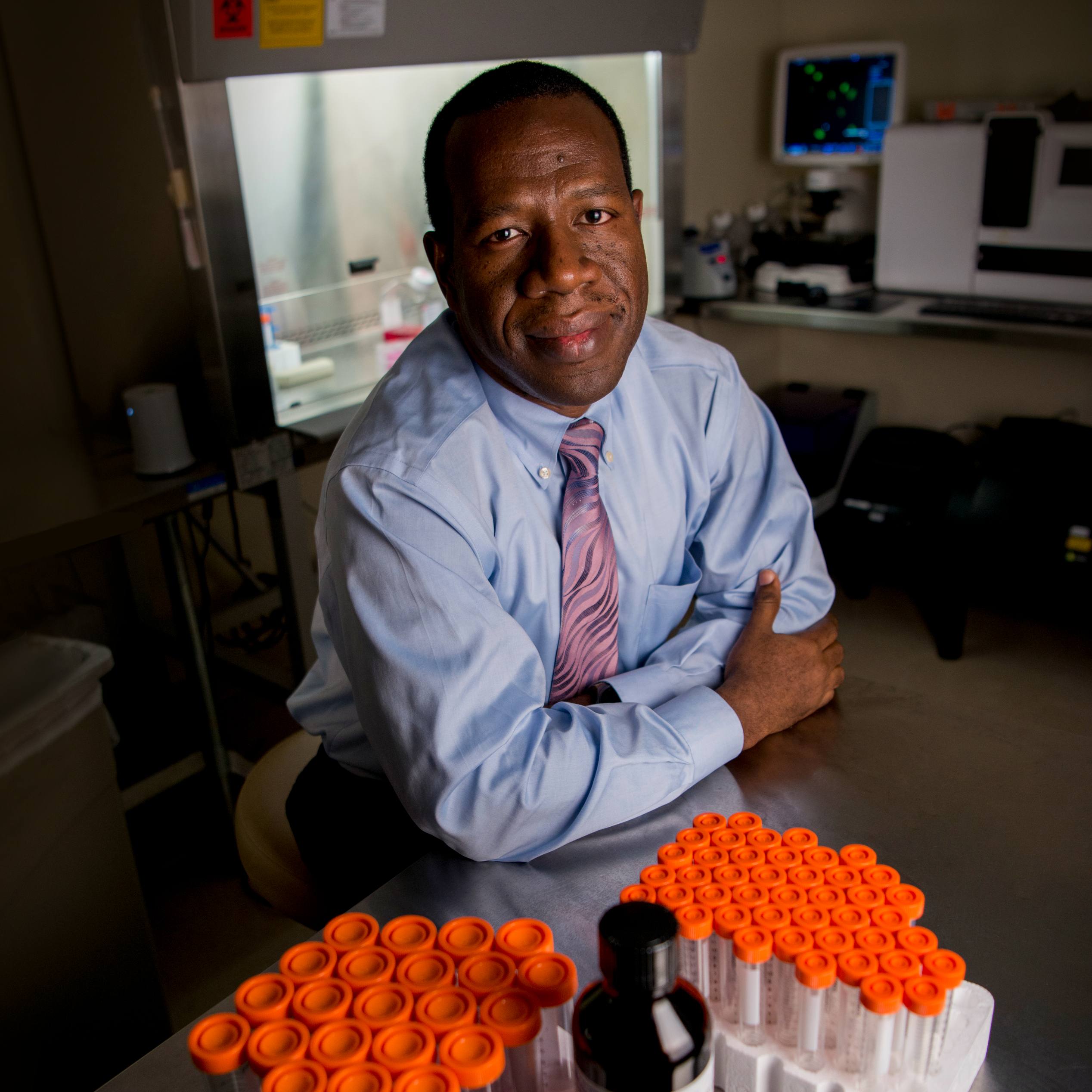To solve the challenges presented by COVID-19, it's important to look to the past. History shows that collaboration is the way forward when uncovering secrets of an emerging virus. It is vital for many reasons, a key one being safety. Only a few labs can safely handle a "live," meaning infectious, sample. No one knows that better than Hideki Ebihara, Ph.D., a Mayo Clinic virologist who leads Mayo's Emerging Virus Program. As a researcher with worldwide connections and deep experience studying emerging diseases, Dr. Ebihara and his lab are vital to Mayo's COVID-19 research efforts. From the lab to clinical trials, and diagnostics to decontamination, Dr. Ebihara's lab is a lynchpin for SARS-CoV-2 research that improves care and fosters a safe working environment at Mayo Clinic. Having this facility to support Mayo's research, medical practice and education activities means good ideas can move into patient care for use when they’re needed.

"The impact of COVID-19 is unprecedented." ― Hideki Ebihara, Ph.D.
Before joining Mayo, Dr. Ebihara studied the family of viruses responsible for Ebola virus disease and Marburg virus disease which generally kill about 50% of those infected, respectively. He has developed and improved various animal models for Ebola, and been involved in Ebola vaccine research. At Mayo, Dr. Ebihara's lab focuses on tick- and mosquito-borne viral diseases. The Emerging Virus Program seeks to develop better ways to predict where, when and how viruses will jump from their original host into humans.
"A crucial step to identifying the Achilles' heel ― the weakest point ― of a new virus comes through better understanding of how the virus infects, replicates and spreads in hosts at the cell, tissue and whole-body levels by interacting with host immune systems," says Dr. Ebihara.
The lab tries to pinpoint the weakest link of a virus in a few ways. The team:
- Determines how a virus copies itself and how it interacts with the host.
- Looks at how the virus-host interaction leads to disease through investigations at the molecular level. This helps identify targets for antiviral drugs and therapeutics.
- Analyzes how viruses change and evolve. This helps develop better diagnosis and prediction algorithms for future emerging viruses.
- Helps develop treatments, including vaccines, antiviral drugs and therapeutics, by testing them against the live virus.
More than 70% of emerging infectious diseases are zoonotic, meaning that they originate in a nonhuman species and jump, or spill over, into human populations, according to Dr. Ebihara.

"Because of this origin, it is almost impossible to eradicate them and difficult to predict them," he says. "Clinical diseases caused by emerging viruses are often severe and have a significant fatality rate due to complicated disease processes."
And, he continues, because of the sporadic nature of the outbreak, development of commercial vaccines and therapeutics against emerging infectious diseases have lagged well behind development of the same tools for more common diseases such as influenza, hepatitis B and anti-HIV drugs.
"These challenges are what we are witnessing during the current COVID-19 pandemic," says Dr. Ebihara.
"We are unique and the most suitable group to conduct research with SARS-CoV-2 safely and securely at Mayo Clinic." – Hideki Ebihara, Ph.D.
Before joining Mayo, Dr. Ebihara's worked at the National Institute of Allergy and Infectious Diseases studying the Ebola virus. This meant his lab had to have the highest level of precautions to minimize the risk of exposure to the virus. This is called a Biosafety Level 4, or BSL-4, lab. There are four designations, ranging from BSL-4 for the highest risk microbes to BSL-1 for the lowest risk. In a BSL-1 lab, researchers may work on something like a laboratory-adapted strain of E. coli that doesn't cause disease in healthy adults. BSL-2 labs have additional safety precautions because researchers work with disease-causing microbes, albeit ones that have treatments or are preventable by vaccines. To work on the viruses Dr. Ebihara's lab focused on when he first joined Mayo, and now SARS-CoV-2, Dr. Ebihara's lab has a BSL-3 designation, which is primarily designed to contain microbes that can be transmitted in the air.

"Our lab has substantial expertise and experience in high-containment research with highly pathogenic and contagious viruses, similar to SARS-CoV-2. Therefore, we are unique and the most suitable group to conduct research with SARS-CoV-2 safely and securely at Mayo Clinic," says Dr. Ebihara.
His BSL-3 lab is distinctively designed and engineered for safety. To prevent contamination, the negative-pressure airflow design pulls clean air into the lab, prevents laboratory air from flowing out and instead forces lab air through a high-efficiency particulate air, or HEPA, filter to remove potential contamination. Facility performance is continually monitored by the laboratory and Mayo's Biosafety Office. Access to the lab is highly regulated and is restricted to scientists who have appropriate training and a specific assignment to the lab. Researchers in the lab must wear enhanced personal protective equipment, including a powered air-purifying respirator that protects against highly contagious respiratory pathogens such as SARS-CoV-2. And in collaboration with Mayo's Occupational Health Service, the health status of the scientists in the lab is monitored to ensure that they have not been infected.
"In addition to having a secure facility, we have redundant safety protocols and operation procedures to protect scientists who work with SARS-CoV-2 in BSL-3, and protect the outside environment and public," says Dr. Ebihara. "Our scientists are well-trained and experienced in conducting research under these safety conditions."
"We need to use a live virus to develop a drug or vaccine — a medical countermeasure" ― Hideki Ebihara, Ph.D.
In general, the lab was set up to perform basic and translational research on any type of BSL-3 pathogenic virus, except those that are federally regulated. So, Dr. Ebihara says, while the fundamental focus of their work did not change, the lab had never studied a coronavirus before. They had to establish all the virus-specific experimental conditions from scratch, which he says could not have been done without the dedication and effort of the people in the lab. The silver lining, however, was that the pandemic accelerated collaborations with other labs at Mayo.
As the only lab to handle live viral samples, it was essential for Dr. Ebihara's lab to support the research and clinical efforts of Mayo staff. Since March, the team set up collaborations internally and externally, testing antiviral drug candidates, providing noninfectious virus samples for use in developing diagnostics and vaccines, and working on projects to validate decontamination methods to eliminate infectious SARS-CoV-2 from health care equipment and the environment. The lab also has partnered with other Mayo Clinic researchers to better understand how SARS-CoV-2 causes severe acute respiratory distress, and what triggers the uncontrolled and harmful immune response. These data are vital in developing therapeutic strategies to treat patients with severe disease.

"Treatment, diagnosis and prevention are the essential elements to counteract any diseases in humans, and we need to support each of these fundamental goals of biomedical research," says Dr. Ebihara. "Our first aim is to accelerate the deployment of therapeutics, then to identify risk factors and biomarkers for severity and outcome. And finally we need to focus on vaccine."
To that end, Dr. Ebihara's lab started experiments to identify which parts of the virus would be excellent targets for generating a protective immune response against SARS-CoV-2. They've also helped Mayo research teams developing vaccines set up experiments to test their candidates.
"Recently, it has been reported that SARS-CoV-2 infection may not elicit long-lasting immunity in the people infected with the virus. Of course, this phenomenon needs to be validated and characterized by many studies," says Dr. Ebihara. "But this strongly emphasizes the importance of vaccine research because SARS-CoV-2 infection itself may not induce sufficient and long-term protective immune response against SARS-CoV-2 infection."
In this case, in addition to social-based protection efforts such as mask-wearing and social distancing, vaccination will be the most effective strategy to protect communities from SARS-CoV-2 infection, says Dr. Ebihara. As a global challenge, this means vaccines across several platforms may be needed to cover all populations, differentiated by age, sex and health status, as well as economic, cultural and social backgrounds.
"In addition to treating patients with COVID-19 in our communities, Mayo has merged its biomedical research efforts with research that take ideas from the lab into patient care," says Dr. Ebihara. "This remarkable advantage makes Mayo Clinic a leader for basic and translational research on SARS-CoV-2 and COVID-19."
— Sara Tiner, July 2020
Looking for more information on COVID-19 topics?
For information on COVID-19, see the Mayo Clinic COVID-19 page.
For more on Mayo’s research related to COVID-19, head over to "Mayo Researchers Double Down on COVID-19."
To read more about the Ebihara lab and their work before the pandemic, check out "Replication: Mentor Trains Student on Tick-Borne Viruses."







